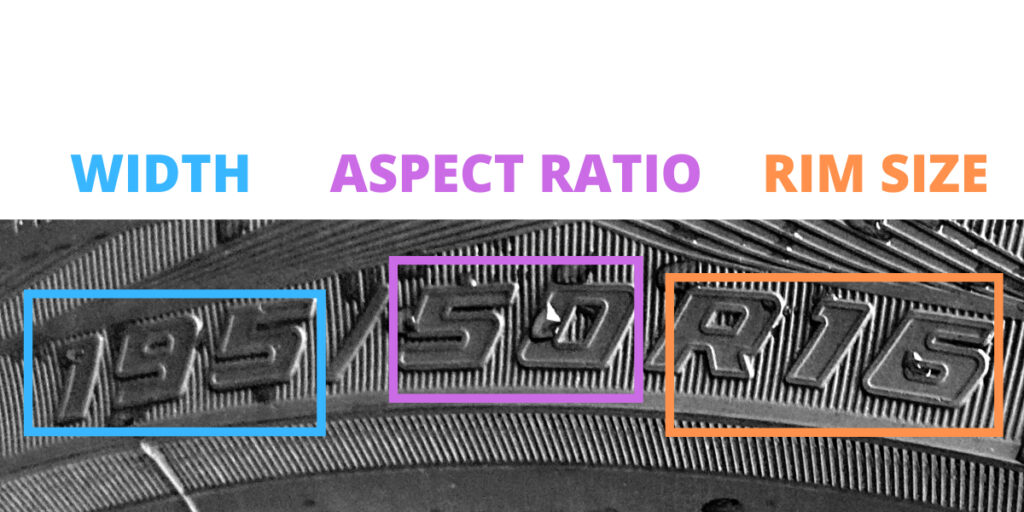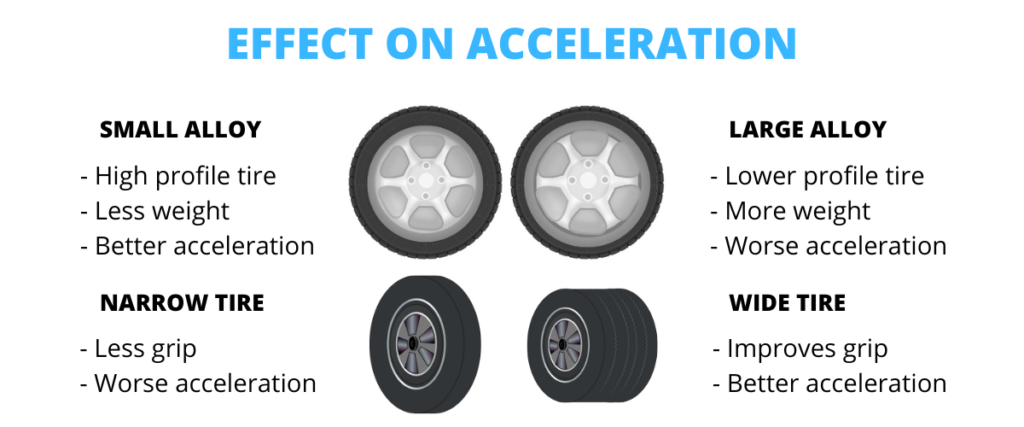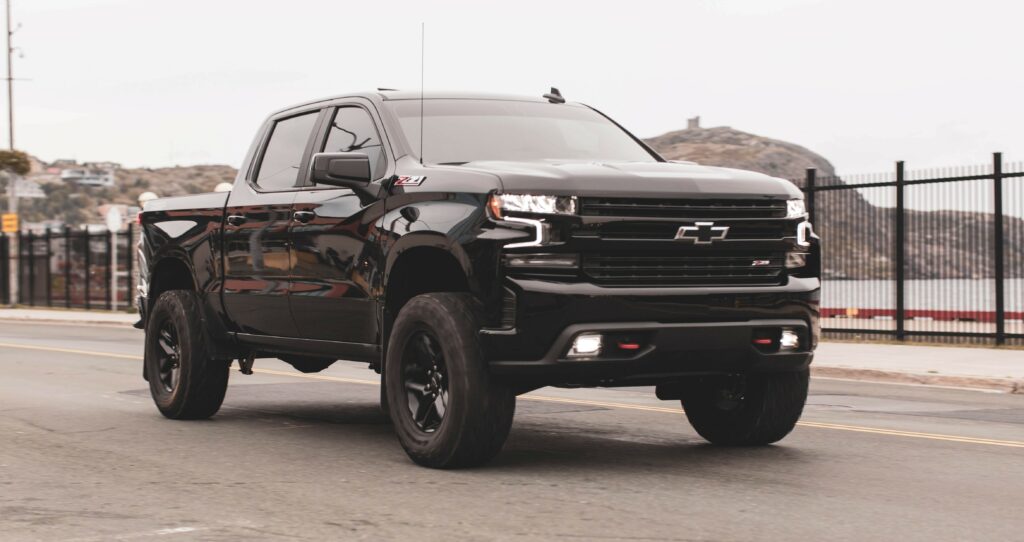Changing the size of your vehicle’s wheels, whether it’s by altering the diameter or the width can influence a whole host of performance aspects.
In this article I’ll explain the difference between small and large wheels in terms of their handling, speed, braking, fuel economy, noise, comfort and more so you know exactly what impact changing the size of your wheels can have.
Does Wheel Size Matter?
Wheel size encompasses two measurements: diameter, and width.
Changes to either or both of these measurements impacts the performance, handling, fuel consumption, comfort etc. so I will be addressing both of them throughout this article.
Larger wheels (increased diameter) have sharper handling in comparison to wheels with a smaller diameter. However, smaller wheels result in better acceleration, fuel efficiency and comfort, as well as less road noise in comparison to larger wheels.
Wider wheels and consequently, wider tires improve acceleration and braking on high-performance cars and makes the handling feel sharper and more sporty. However, wider wheels result in more road noise, lower fuel consumption and less aquaplaning resistant compared to narrower wheels.
| Driving Aspect | Effect of Wheel Diameter | Effect of Wheel Width |
| Acceleration | Increasing diameter reduces acceleration | Increasing width improves acceleration |
| Top Speed | Increasing diameter can sometimes increase top speed | No direct effect |
| Handling | Increasing diameter makes handling sharper | Increasing width makes handling sharper |
| Braking | No direct effect | Increasing width improves braking time |
| Aquaplaning Resistance | No direct effect | Increase width results in less aquaplaning resistance |
| Comfort | Increasing diameter reduces comfort | Increasing width reduces comfort |
| Fuel Consumption | Increasing diameter increases fuel consumption | Increasing width increases fuel consumption |
| Road Noise | Increasing diameter increases road noise | Increasing width increases road noise |
Contents:
- Wheel Size 101
- Performance
- Comfort
- Fuel Consumption
- Noise Level
- Appearance
- Height/ Ground Clearance
- Effect on Speedometer
Wheel Size 101
As I just mentioned, there are two aspects to discuss in terms of “wheel size”: diameter and width.
Changing the diameter or width of a wheel will also affect the suitable tire size. This is important to note as it’s often the change of the tire size which has the direct affect on the car’s performance.
The size of the tire is denoted on the tire wall and consists of three measurements:
- Width – measured in mm
- Aspect Ratio – this is a percentage of the width and determines the height of the sidewall
- Diameter – indicates what size alloy the tire will fit
Let’s take an example:

- This tire measures 195/50 R16
- The width of the tire is 195 mm
- The aspect ratio is 50, so the side wall height is 50% of 195 mm which equals 97.5 mm
- The tire is designed to fit a 16″ wheel
When you increase the diameter of a wheel, you need to decrease the sidewall height (aspect ratio) in order to make sure the overall size of the wheel is a close match so it will fit in the wheel arch.
For example:
- If you have a 16″ wheel with a tire size of 195/ 50 R16 and want to increase the diameter to a 17″ wheel then you’ll need to decrease the sidewall height
- An appropriate size for the new tire would be 195/ 45 R17 as this is a close match in terms of the overall wheel size
Performance
Increasing the diameter of a wheel decreases acceleration but improves handling by making it feel sharper. Increasing the width of the wheel, and consequently the width of the tire, improves braking but decreases acceleration and aquaplaning resistance.
Performance encompasses many different factors so I’ll be splitting this section down into some different aspects and diving into them in a little more detail.
- Speed and Acceleration
- Handling
- Braking
- Aquaplaning

Speed and Acceleration
Wheels with a larger diameter have less acceleration compared to narrower and smaller wheels. This is because larger wheels are heavier, meaning more power is required to get the car to accelerate. Hence, if you go up a wheel size, or increase the width, the 0-62 mph time can decrease slightly, if all other variables are kept the same.
Having larger wheels can increase the top speed of the car, but only if the overall size of the wheel is increased and the tyre wall height is not decreased to compensate, and if the car has enough power.
When increasing wheel size from say 18″ to 19″, most people will decrease the sidewall height of the tyre to compensate and keep the overall wheel size the same. However, if the overall size of the wheel is increased, then each tire revolution will cause the car to move further.
Despite this, in a lot of cases this will not impact the top speed because it is usually limited by the power of the car, and not the size of the tyres.
The effect of wheel width, and consequently tire width on speed and acceleration is a little more complicated still…
Increasing the width of the tire offers more grip and improves acceleration HOWEVER this is only the case if the car has a sufficient amount of horsepower. If the car doesn’t have the horsepower to require the extra grip it can decrease acceleration by adding more weight (similarly to increasing the wheel diameter).
Summary:
- Increasing the diameter of the wheels decreases acceleration
- Increasing the overall wheel diameter can increase top speed but only if power is not the limiting factor
- Wider wheels increase acceleration but only if the car has enough power

Handling
Increasing the size of the wheel means the sidewall height of the tire must be reduced in order for the wheel to comfortably sit in the arch. Hence, larger wheels have “lower profile” tires which have a stiffer sidewall to compensate for the lack of height.
Larger wheels with lower-profile tires have sharper handling making them feel more sporty due to the stiffer sidewall which improves cornering and stability.
Wider wheels have wider tires which offer more grip when turning, again making the handling feel sharper and more sporty in comparison to narrow wheels and tires.
The extra weight of wider and larger diameter wheels can also make the steering feel a bit heavier, which many drivers find is synonymous with a “sporty feel”.
Summary:
- Larger wheels have lower-profile tires which offer sharper and more sporty handling
- Wider wheels offer more grip when turning making the car feel sportier

Braking
Wider wheels and tires have better braking performance compared to narrower wheels and tire. The wider tire found on a wider wheel puts more rubber in contact with the road by increasing the surface area, hence results in more grip.
Wheel diameter does not have any significant impact on braking performance.
Aquaplaning
Narrower wheels and tires offer better aquaplaning resistance in comparison to wider wheels and tires. This is because wider tires have a tendency to float more on water surfaces because the tire has more distance to clear the water. Hence, for driving in the rain and snow, narrower wheels and tires are more suitable.

Comfort
Increasing the diameter of the alloy means the sidewall height of the tire will need to be decreased if the overall wheel size is to be kept the same. Hence, it’s really the difference between high-profile and low-profile tires which results in the difference in comfort.
Larger wheels with lower-profile tires make the ride feel harsher and firmer in comparison to smaller wheels with higher-profile tires. Low-profile tires are also more at risk of blow outs.
This is because high-profile tires offer more cushioning to absorb the shock of potholes and speedbumps.
Wider wheels and tires are less comfortable compared to narrow wheels and tires. This is because wider tires feel more rigid and hence result in a harsher ride.
Summary:
- Larger diameter wheels have lower-profile tires which feel less comfortable
- Wider wheels feel less comfortable since they are stiffer

Fuel Consumption
Wheels which are wider and have a larger diameter are heavier compared to smaller and narrower wheels, this means they have more rolling resistance. Hence, wider and larger diameter wheels increase fuel consumption and make the car less economical result in a lower MPG figure.
In other words, a car with 195/50 R16 tires doesn’t have to work as hard to travel the same distance at the same speed compared to a car with 205/45 R17 tires. This is assuming that the wheels and tires are the same brand and model.
It’s important to note that the weight of the wheels varies massively between brands and models and can have a far greater impact on fuel consumption than simply just the size. The model of tire also has a huge impact on fuel economy as well.
Summary:
- Larger diameter/ wider wheel and tires are less fuel efficient

Noise Level
Fitting a car with wider wheels, and hence wider tires results in more road noise since the wheels have a greater contact patch with the road. Switching to wheels with a larger diameter and hence, lower-profile tires will also increase road noise.
However, it’s important to note that the difference is not that much at all unless you are increasing it by a few sizes.
I switched from 195/50 R17 to 205/45 R16 tires on my car and didn’t notice a difference. Unless you are trying the wheels back to back on the same car, you’d be hard pushed to notice the change.
It’s also very important to recognise that different tires have different noise level ratings. Some tires are much louder than others, so it’s likely that switching up the brand/ model of tire will have the same or even a greater impact on the level of road noise compared to switching up the size.
Summary:
- Wider and larger diameter wheels result in more road noise
- Increasing the size of the wheels by 1-2″ or 10-20 mm in width is unlikely to have a huge impact
Appearance
In general, most people prefer the look of wider diameter wheels with lower profile tires. This is why pretty much every car manufacturer offers larger wheels with the more expensive trim option on a new car. Wider wheels and tires also tend to look better because they are synonymous with high-powered sports vehicles.
Effect on Height/ Ground Clearance
Changing the diameter of a wheel can have an impact on the height/ ground clearance of the vehicle however in most cases it does not.
This is because typically when the diameter of the wheel is increased, the tire’s sidewall height is decreased to compensate, resulting in the same overall wheel size.
Of course, there are exceptions and some car owner’s like to increase both the wheel diameter and the tire sidewall height (or at least keep it similar to the stock height) and this results in more ground clearance as the height of the vehicle is increased.
This can have complications though as there is a risk that the wheel will be too large for the arch. Hence this should only be done if you are confident about the fitment.

Effect on Speedometer
Increasing the diameter of the wheel usually has little to no effect on the speedometer reading as the tyre sidewall height is decreased to keep the overall wheel size the same.
However, if the sidewall height of the tire is not decreased, the overall wheel size will increase. This means that the car will travel further per wheel rotation. Hence, the speedometer will say the car is going slower than it actually is.
Let’s consider an example to explain this properly.
- The car has a stock tire size of 205/50 R17.
- The wheels size is increased to 205/ 50 R18.
- In this case the speedometer will read 70 km/h when the car is actually travelling 73 km/h.
In order to prevent the speedometer reading inaccurately, you can either recalibrate it or choose an overall wheel size similar to the stock wheel size by decreasing the tyre aspect ratio (sidewall height).
Here’s an example.
- If a car has a stock tire size of 205/50 R17 then you can decrease the sidewall height and fit the wheel with a 205/45 R18 tire
- In this case the speedometer will read 70 km/h when the car is actually travelling 70.5 km/h
As a general rule of thumb, if the width of the tire stays the same and only the diameter is changing, you can decrease the aspect ratio by 5% (e.g. from 50 to 45 in the example above) if the diameter is going up by 1″ and this shouldn’t have a huge impact on the speedometer.

